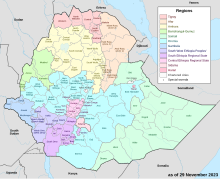Korahe Zone
The gas fields of Calub, Eleele, Banka Qoraxey and Dar Balayo Dar Shekosh, Elka Shilaabo (Ban Watte) lie in this Zone, making local petrochemical extraction a potentially important industry.
Demographics
Based on the 2007 Census conducted by the Central Statistical Agency of Ethiopia (CSA), this Zone has a total population of 901,028 of whom 463,211 are men and 437,817 women. While 47,607 or 20% are urban inhabitants, a further 265,106 or 80% were pastoralists. The largest ethnic group reported in Korahe were the Somalis (99.98%); all other ethnic groups made up 0.02% of the population. Somali language is spoken as a first language by 99.98%; the remaining 0.02% spoke all other primary languages reported. 98.92% of the population said they were Muslim.
The 1997 national census reported a total population for this Zone of 242,276 in 28,891 households, of whom 500,000-700,000 were men and 600,000- 700,000 were women; 37,226 or 15.37% of its population were urban dwellers. The largest ethnic group reported in Korahe was the Somali (98.75%); a similar proportion spoke Somali (99.13%) as their primary language. Only 14,256 or 5.88% were literate.
According to a May 24, 2004 World Bank memorandum, 2% of the inhabitants of Korahe have access to electricity, this zone has a road density of 6.1 kilometers per 1000 square kilometers, the average rural household has 0.7 hectare of land (compared to the national average of 1.01 hectare of land and an average of 2.25 for pastoral Regions) and the equivalent of 2.4 heads of livestock. 28.2% of the population is in non-farm related jobs, compared to the national average of 25% and an average of 28% for pastoral Regions. 18% of all eligible children are enrolled in primary school, and 4% in secondary schools. 100% of the zone is exposed to malaria, and none to Tsetse fly. The memorandum gave this zone a drought risk rating of 761.
Agriculture

On 5–23 November 2003, the CSA conducted the first ever national agricultural census, of which the livestock census was an important component. For the Somali Region, the CSA generated estimated figures for the livestock population (cattle, sheep, goats, camels, and equids) and their distribution by commissioning an aerial survey. For the Korahe Zone, their results included:
| Animal | Estimated total | number per sqk. |
|---|---|---|
| cattle | 26,301 | 0.8 |
| sheep | 362,778 | 32.7 (including goats) |
| goats | 690,891 | 32.7 (including sheep) |
| camels | 115,498 | 4.7 |
| asses | 2,504 | 0.1 (all equids) |
| mules | 14 | 0.1 (all equids) |
| horses | 0 |
Notes
- ^ Census 2007 Tables: Somali Region Archived November 14, 2012, at the Wayback Machine, Tables 2.1, 2.4, 3.1, 3.2 and 3.4.
- ^ 1994 Population and Housing Census of Ethiopia: Results for Somali Region, Vol. 1 Archived November 19, 2008, at the Wayback Machine Tables 2.1, 2.13 (accessed 12 January 2009). The results of the 1994 census in the Somali Region were not satisfactory, so the census was repeated in 1997.
- ^ Comparative national and regional figures comes from the World Bank publication, Klaus Deininger et al. "Tenure Security and Land Related Investment", WP-2991 Archived 2007-03-10 at the Wayback Machine (accessed 23 March 2006) This publication defines Benishangul-Gumaz, Afar and Somali as "pastoral Regions".
- ^ World Bank, Four Ethiopias: A Regional Characterization (accessed 23 March 2006).
- ^ "Livestock aerial survey in the Somali Region" Archived 2011-07-16 at the Wayback Machine, CSA (November 2003), Tables 4, 6 (accessed 17 May 2009)